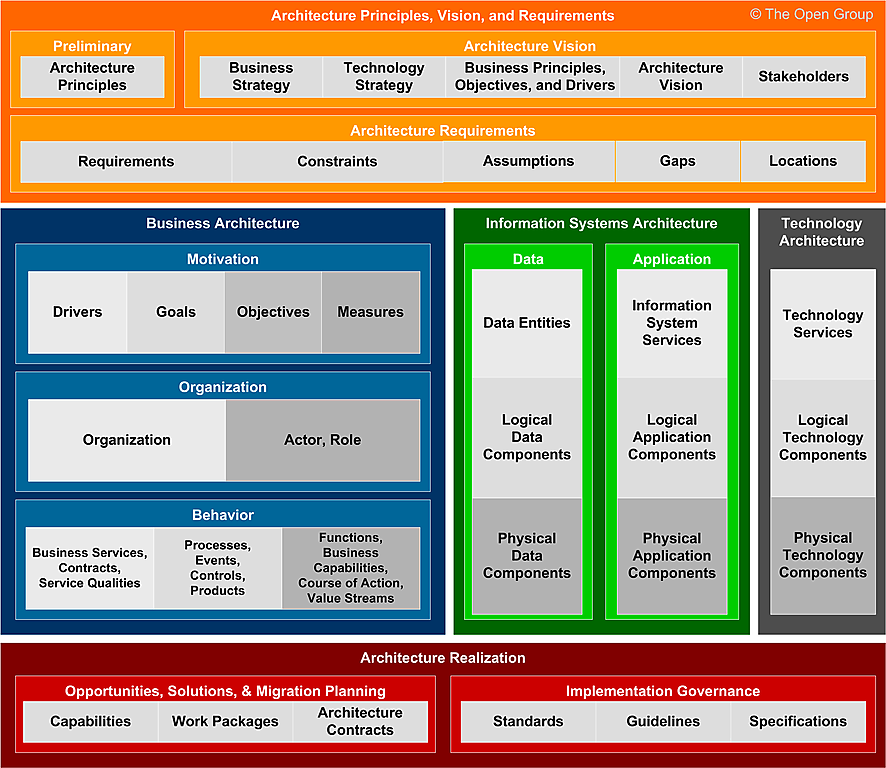Introduction
The Architecture Content Framework within The Open Group Architecture Framework (TOGAF) plays a pivotal role in establishing TOGAF as a comprehensive and self-sufficient framework for enterprise architecture. This framework employs a structured approach to categorize various architectural work products, utilizing core metamodel concepts and extension modules.
By doing so, it provides a solid foundation for the development and management of enterprise architectures. This guide delves into the intricacies of the Architecture Content Framework, exploring its core concepts, metamodel entities, and the diverse set of artifacts produced across different phases of the Architecture Development Method (ADM).
What is Architecture Content Framework
The Architecture Content Framework is a crucial aspect of The Open Group Architecture Framework (TOGAF). It serves to make TOGAF a comprehensive and standalone framework for enterprise architecture. This framework utilizes three main categories to describe various types of architectural work products. 
These categories are:
- Core and Extension Content:
- TOGAF utilizes a fundamental core metamodel and incorporates extension modules to address specific architectural concerns.
- It provides a minimum set of architectural content that supports traceability across artifacts.
- Formal and Information Modeling:
- This involves structuring architectural information in a systematic manner to meet the needs of stakeholders effectively.
- Core Metamodel Entities:
- These entities have key relationship concepts:
- Processes describe flow.
- Functions represent units of business capability.
- Business services support organizational objectives and are defined at a governance-appropriate level of granularity.
- Business services are deployed onto application components.
- Application components are deployed onto technology components.
- These entities have key relationship concepts:
- Catalog, Matrix, and Diagram Concepts:
- Catalogs: Lists of building blocks for reference or governance, which can be queried and analyzed.
- Matrices: Display relationships between two or more model entities in a grid format.
- Diagrams: Render architectural content graphically, facilitating stakeholders in retrieving required information.
Core Content Metamodel Entities
Preliminary Phase
- Principles Catalog:
- Captures the foundational principles that guide the architecture development process.
Architecture Vision Phase
- Stakeholder Map Matrix:
- Illustrates relationships and concerns of stakeholders.
- Value Chain Diagram:
- Represents the series of value-adding activities within an organization.
- Solution Concept Diagram:
- Outlines the conceptual solution for addressing business problems.
Business Architecture Phase
- Organization/Actor Catalog:
- Describes the organizational units and external entities.
- Role Catalog:
- Identifies different roles within the organization.
- Business Service/Function Catalog:
- Lists business services and functions.
- Business Interaction Matrix:
- Illustrates interactions between business entities.
- Actor/Role Matrix:
- Describes relationships between actors and roles.
- Business Footprint Diagram:
- Displays the footprint of business functions.
- Business Service/Information Diagram:
- Represents the relationship between business services and information.
- Functional Decomposition Diagram:
- Breaks down business functions into sub-functions.
- Product Lifecycle Diagram:
- Demonstrates the lifecycle of products.
Information Systems (Data Architecture) Phase
- Data Entity/Data Component Catalog:
- Lists data entities and components.
- Data Entity/Business Function Matrix:
- Shows the relationships between data entities and business functions.
- System/Data Matrix:
- Illustrates relationships between systems and data entities.
- Class Diagram:
- Represents classes and their relationships.
- Data Dissemination Diagram:
- Depicts how data is disseminated within the organization.
Information Systems (Application Architecture) Phase
- Application Portfolio Catalog:
- Lists applications within the enterprise.
- Interface Catalog:
- Describes interfaces between applications.
- System/Organization Matrix:
- Illustrates relationships between systems and organizations.
- Role/System Matrix:
- Describes the relationships between roles and systems.
- System/Function Matrix:
- Shows relationships between systems and functions.
- Application Interaction Matrix:
- Demonstrates interactions between applications.
- Application Communication Diagram:
- Represents communication between applications.
- Application and User Location Diagram:
- Illustrates the locations of applications and users.
- System Use-case Diagram:
- Shows the use cases of systems.
Technology Architecture Phase
- Technology Standards Catalog:
- Lists technology standards.
- Technology Portfolio Catalog:
- Describes the technology portfolio.
- System/Technology Matrix:
- Illustrates relationships between systems and technologies.
- Environments and Locations Diagram:
- Depicts the environments and locations of technologies.
- Platform Decomposition Diagram:
- Breaks down platforms into sub-platforms.
Opportunities and Solutions Phase
- Project Context Diagram:
- Provides a context for specific projects.
- Benefits Diagram:
- Illustrates the benefits of architectural solutions.
Requirements Management Phase
- Requirements Catalog:
- Lists and manages requirements.
Extension Modules
Extension modules in TOGAF are optional and are chosen during the Preliminary phase based on the organization’s needs. The available extension modules are:
- Governance Extensions:
- Enhances governance aspects within the architecture development process.
- Services Extensions:
- Focuses on services related to the architecture.
- Process Modeling Extensions:
- Extends the framework with additional process modeling capabilities.
- Data Extensions:
- Provides additional capabilities and guidelines for managing data in the architecture.
- Infrastructure Consolidation Extensions:
- Aids in the consolidation of infrastructure components.
- Motivation Extensions:
- Enhances the framework with additional capabilities related to motivation and strategy.
By following the Architecture Content Framework, organizations can effectively manage and document their architectural artifacts throughout the enterprise architecture development process, ensuring alignment with business goals and objectives.
Summary
The Architecture Content Framework in TOGAF is a structured and systematic approach to enterprise architecture development. It encompasses core content metamodel entities, formal and information modeling, and categorizes architectural work products into catalogs, matrices, and diagrams. Each phase of the ADM contributes specific artifacts, ranging from principles catalogs in the Preliminary phase to benefits diagrams in the Opportunities and Solutions phase.
The core metamodel entities establish key relationships between processes, functions, business services, and technology components. Additionally, extension modules, selected during the Preliminary phase, offer optional enhancements tailored to the organization’s specific needs, covering areas such as governance, services, process modeling, data, infrastructure consolidation, and motivation. By following this framework, organizations can effectively manage their architectural artifacts, ensuring alignment with business objectives throughout the enterprise architecture development process.